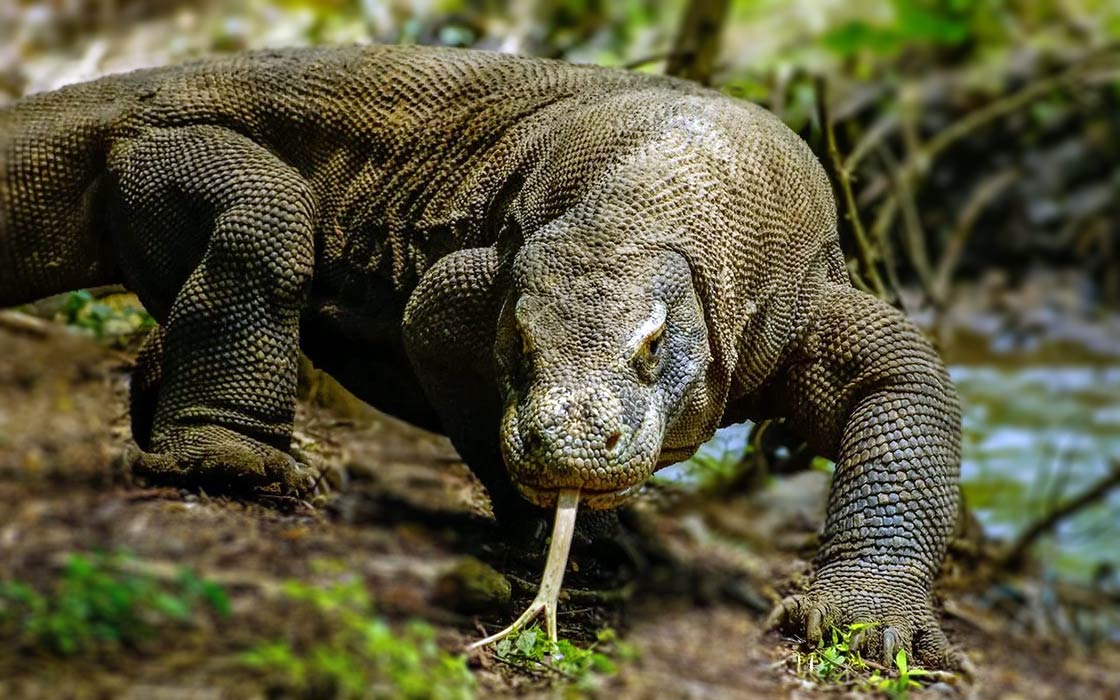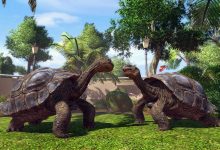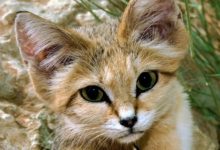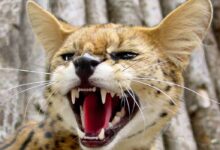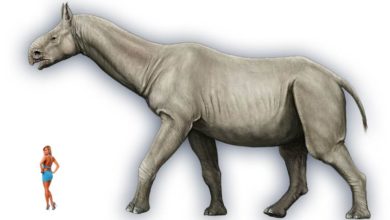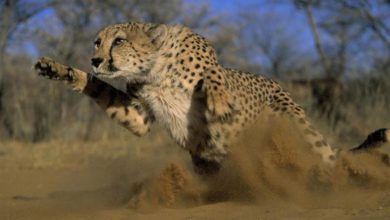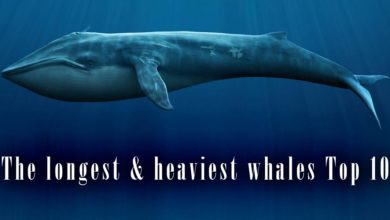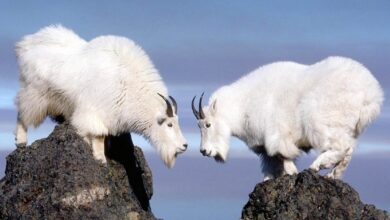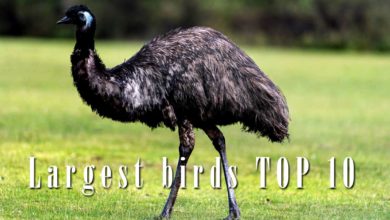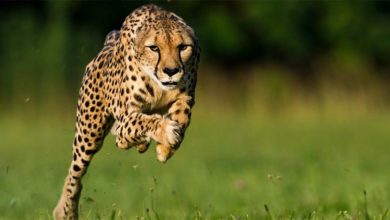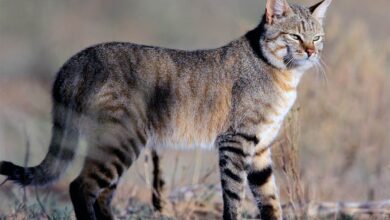Komodo dragon, Komodo monitor (Varanus komodoensis)
The legendary dragon appears out of nowhere, is ruthless, terrifying, and intriguing in its own way because little is known about it. The term “dragon” fits perfectly with the Komodo monitor (Varanus komodoensis) – the largest living lizard on Earth…
The Komodo dragon is a fascinating and enigmatic creature, shrouded in mystery and legend. Known as the world’s largest lizard, these formidable predators can grow up to 3 meters (10 feet) in length and weigh over 160 kg (350 pounds). Found exclusively on a handful of Indonesian islands, the Komodo dragon has captured the imaginations of people around the world with its impressive size, powerful jaws, and venomous bite.
Despite being a modern-day reptile, the Komodo dragon is often described as a living dinosaur, harkening back to a time when giant reptiles roamed the earth. In this article, we will delve into the world of the Komodo dragon, examining its anatomy, habitat, and behavior, and uncovering the secrets behind its incredible adaptations and hunting strategies. So get ready to embark on an exciting journey into the world of the Komodo dragon, and discover what makes this remarkable creature so unique and captivating.
Classification
- Kingdom: Animalia
- Phylum: Chordata
- Class: Reptilia
- Order: Squamata
- Family: Varanidae
- Genus: Varanus
- Subgenus: Varanus
- Species: Varanus komodoensis
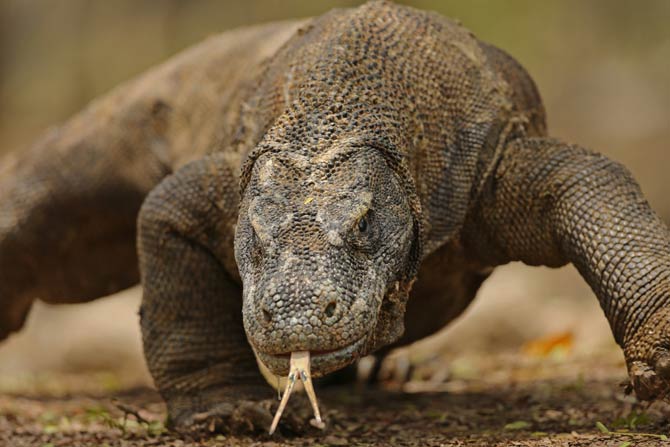
Occurrence
Although Indonesia consists of more than 17 000 islands, only on 5 of them (Komodo, Rinca, Flores, Gili Motang, Padar – islands belonging to the Sunda archipelago) you can meet the Komodo dragon.
The possibility of getting to know these animals better is hindered by the conditions in which they live. They stay on islands hostile to humans – dry and secluded.
In total, about 5,000 individuals live on all 5 islands, which makes the Komodo dragon a species threatened with extinction.
On Komodo – the island with the most dragons – a national park has been established to protect the endangered mighty lizards.
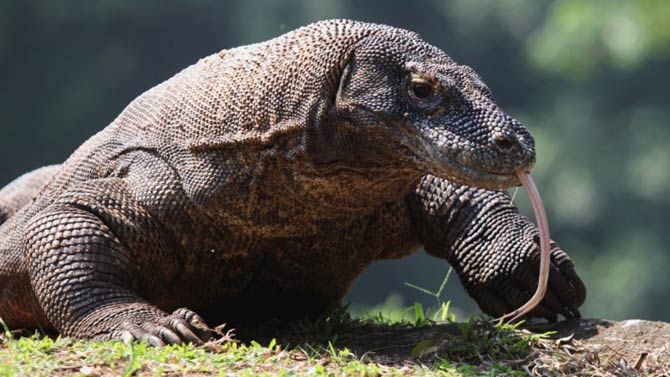
When did Komodo dragons appear?
Komodo dragons appeared most likely in the Pliocene on the Australian continent. Based on the oldest fossil finds, it is estimated that Komodo dragons exist on Earth from about 3.8-3.6 million years ago until today. By migrating from Australia, they colonized the islands of Indonesia, which became their home.
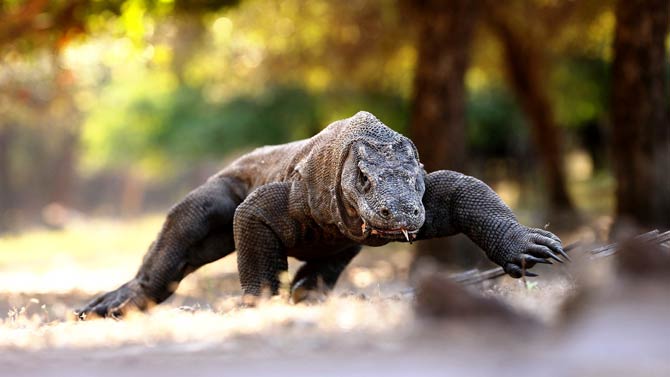
Characteristic
Appearance and senses
A glance at the Komodo dragon is enough to understand why it is called a dragon. This lizard has a large, wide, flattened head, a strong, thick neck, a long “cylindrical” body and a powerful, long tail, wide at the base and tapering towards the end. Laterally flattened and its length is equal to half the length of the body.
The most powerful weapons of the Komodo dragon are 60 sharp and strong teeth and… saliva.
Because it feeds on carrion, its saliva is full of all kinds of bacteria, dangerous to health and life – similar to Tyrannosaurus. Scientists, however, are more and more in favor of the theory that there are venom glands under the jaw that secrete a dangerous venom that causes slow death. On contact with Komodo saliva (or venom), blood pressure and clotting decrease. The victim loses consciousness, bleeds out, or dies of infected wounds.
In the wild, the Komodo dragon reaches a weight of 70 kg (154 lb). Its mass, however, may be greater. There are individuals of 90 (198 lb) or even 160 kilos (353 lb). However, there are fewer and fewer of them, probably due to the decreasing number of large game that the Komodo dragon hunts.
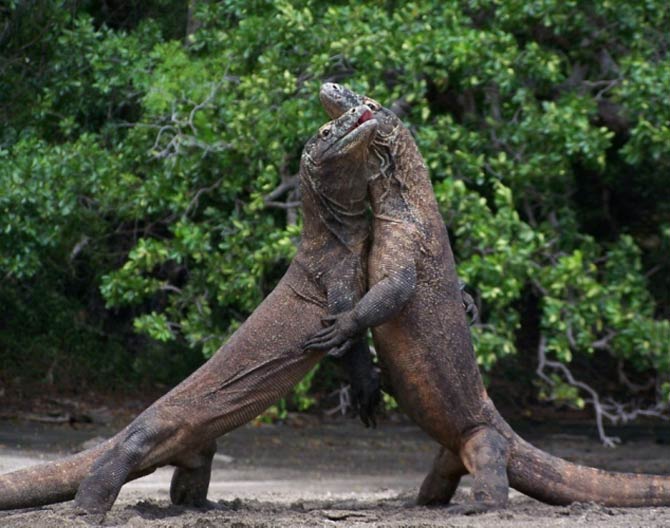
Smell and taste
The Komodo dragon relies most on the sense of smell and taste. He can see well up to 300 meters (984 ft), but only in good lighting. This is due to the lack of rods (it had only cones) on the retina of the eye. He has poor hearing – he is able to hear sounds with a frequency between 400 and 2000 Hz.
With his nose and tongue, he senses food. The split-tip of the tongue catches food particles in the air and soil. From there they go to the sensory organ located in the palate – see: Snakes.
Scales
The entire body of the lizard is covered with spherical scales that act as a kind of chain mail. It is very resistant to injuries, an essential trait when fighting for food or a female.
There are more adult males than females on Komodo.
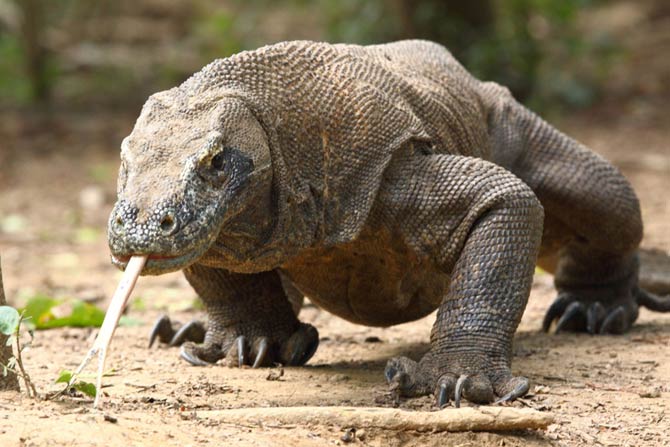
Lifestyle and character
The Komodo dragon is a carnivore, often a cannibal. Adult dragons are the greatest threat to young dragons. However, the Komodo dragon is not lazy – it is able to hunt a victim 10 times bigger than it. It will not despise a large mammal (water buffalo, wild pig, horse, deer).
When a smaller prey is found, the Komodo dragon throws itself into its throat, the large prey it tries to knock to the ground first. It proves enormous – dragon’s – strength. A good “helper” when attacking a large animal is a strong dragon’s tail. It is a lethal weapon, striking with a force of 2 tons. There is not much left of the hunted animal – the Komodo dragon will even eat hooves, bones and skin.
The Komodo dragon is at the top of the food chain – it has no natural enemies. It can hunt a victim 10 times its size.
A lizard’s tail is a great weapon in combat. It hits the victim with a force of… 2 tons.

It is most active during the day, and at night he rests in his hole, which he has dug himself. It lives alone, but can hunt together with other dragons. However, he must be careful, because it is easy to find conflicts and fights between the hunters.
According to the hierarchy, the largest individual of the herd begins the feast. Young males, however, fight with the old ones for food, but also for females, i.e. domination in a broad sense. The clashes are evidenced by a large number of scars on the body of the Komodo dragon. To scare the rival from the female, the male strikes the opponent warningly, but painfully, with its long tail. If it does not withdraw, there is a battle.
The Komodo dragon is one of the most intelligent creatures. It remembers and learns. Once trapped, they are much more careful the second time they come across the cage with the carrion attached inside. Hence, it is often difficult to catch a dragon for research, which is important in the Komodo National Park.
The size of the Komodo dragons’ territories remains a mystery.
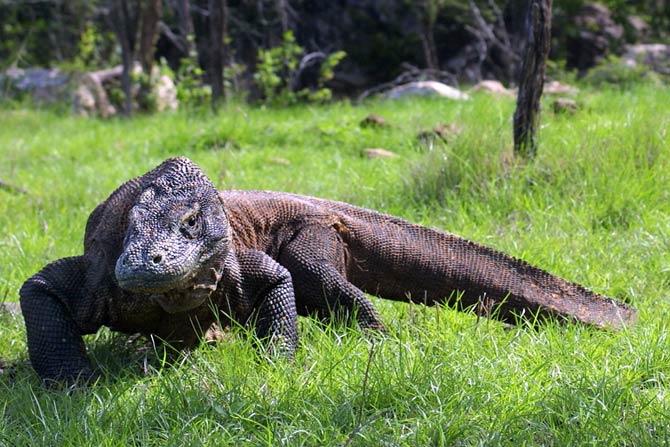
Mating season and reproduction
The mating season is from May to August. One of the elements of the many hours of “mating dance” is scratching the female by the male. During this time, it guards its female, driving away other rivals. In September, females lay their eggs in the nests they dug. This is also where the dragon intelligence manifests itself. Females often dig out the so-called fake nests, possibly to confuse wild boars that like to eat dragons’ eggs. The female lays about 20 eggs, each about 12 cm long. The young hatch after about 7-8 months. During this time, the mother visits her nest regularly to protect the eggs from other animals.
The young Komodo dragon is approximately 30 cm (11.8 in) long. After leaving the nest, it has to deal with itself. Adult dragons are the greatest threat to a baby dragon, so he spends his early years on a tree, feeding on small mammals, lizards, insects and eggs. After about 6 years, the dragon reaches a length of 2 meters (6.5 ft). She reaches sexual maturity at the age of 10.
It has been discovered that female Komodo dragons can reproduce by parthenogenesis (virgin birth). This means that the young are only formed from an egg, without the sperm ‘help’.
This is a rare phenomenon among reptiles. However, it is not a very positive phenomenon as it reduces genetic diversity among individuals.
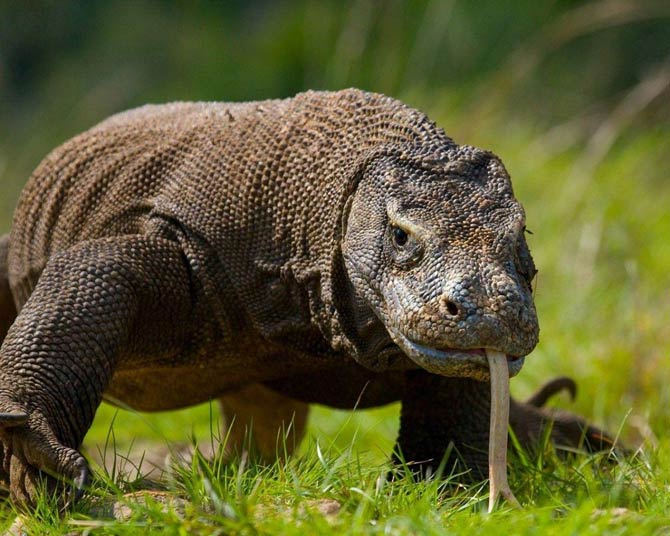
Data / dimensions (size)
Komodo dragon (Varanus komodoensis)
- Length: 2.2 – 3.13 m (7.2 – 10.3 ft).
- females on average: 2.29 m (7.5 ft)
- males on average: 2.59 m (8.5 ft); record: 13 m (10.3 ft)
- Weight:
- males: 79–91 kg (174 – 201 lb); record – 166 kg (366 lb)
- females: 68–73 kg (150 – 161 lb)
- Tail length: half the total length of the body
- Lifespan: up to 50 years (on average 30 years)
- Speed: 21 km/h (13 mph)

Komodo dragon – interesting facts
- Population – about 5,000 Komodo dragons (about 3,200 in the wild).
- A Komodo dragon can sense food from a distance of 10 km (6 miles).
- Komodo dragons were not discovered by the western world until 1910.
- On Komodo – the island with the most dragons – a national park has been established to protect the mighty lizards in danger of extinction.
- The Komodo dragon is at the top of the food chain – it has no natural enemies.
- There are more adult males than females on Komodo.
- The size of the Komodo dragons’ territories remains a mystery.
- On islands, dragons often starve to death, possibly due to the mass killing of large game, especially deer.
- Contrary to popular belief, the Komodo dragon does not attack people notoriously, it is easy to drive away by throwing stones at it.
- The Komodo dragon is able to dig up a human corpse in order to eat it. On the islands where dragons live, concrete tombs are built to prevent such incidents.
- In the morning, lizards take their heat from the sun. The Komodo dragon’s body slowly warms up thanks to the sun’s rays. After the morning “tanning”, the dragon is ready for hunting.
- The Komodo dragon lurks around the potential victim’s tracks, attacks it by surprise from behind.
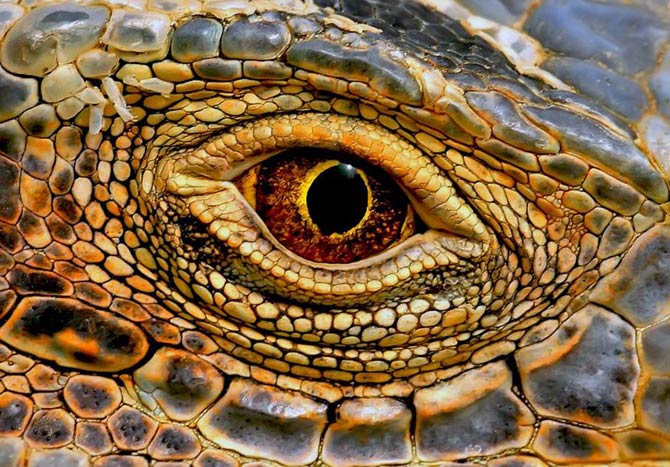
Recommended
- Dragons
- Komodo National Park
- Most venomous snakes – Top 100
- Snakes
- Cobras – fearsome snakes
- Rattlesnakes
- Black mamba
- Inland taipan
- Anaconda
- Titanoboa
- Longest snakes
- Fastest animals
- Fastest birds
- Largest eagles

